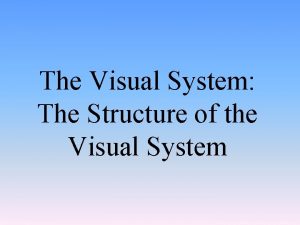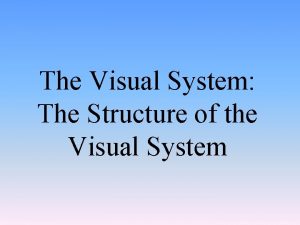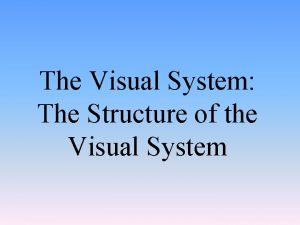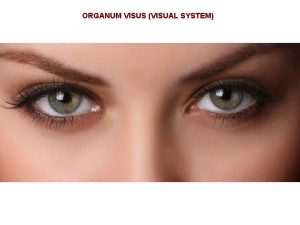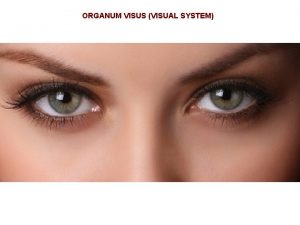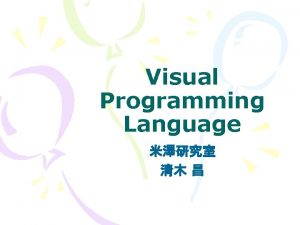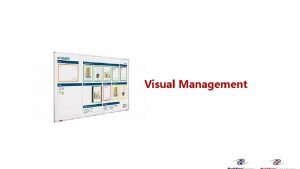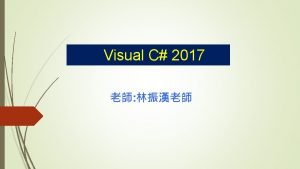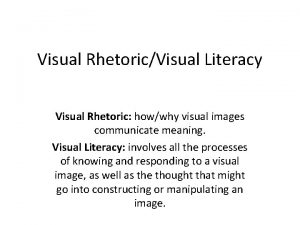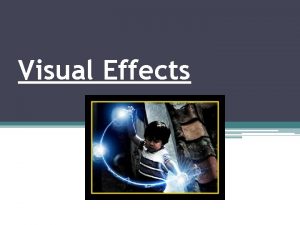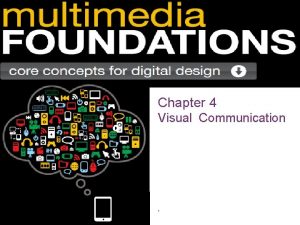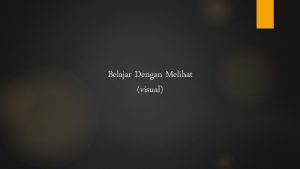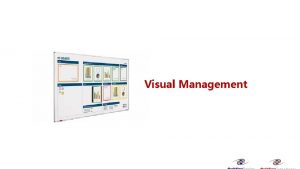The Visual System The Structure of the Visual









































- Slides: 41

The Visual System: The Structure of the Visual System

Cornea • The clear bulge on the front of the eyeball • Begins to focus the light by bending it toward a central focal point • Protects the eye

Parts of the Eye – Cornea

Iris • A ring of muscle tissue that forms the colored portion of the eye; creates a hole in the center of the iris (pupil) • Regulates the size of the pupil by changing its size-allowing more or less light to enter the eye

Parts of the Eye - Iris

Pupil • The adjustable opening in the center of the eye that controls the amount of light entering the eye (surrounded by the iris) • In bright conditions the iris expands, making the pupil smaller. • In dark conditions the iris contracts, making the pupil larger.

Parts of the Eye - Pupil

Lens • A transparent structure behind the pupil; focuses the image on the back of the eye (retina) • Muscles that change thickness of the lens change how the light is bent thereby focusing the image • Glasses or contacts correct problems in the lens’ ability to focus.

Parts of the Eye - Lens

Nearsighted - Myopia

Farsighted - Hyperopia




Retina • Light-sensitive surface with cells that convert light energy to nerve impulses • At the back of the eyeball

Parts of the Eye - Retina

Receptor Cells • These cells are present in every sensory system to change (transduce) some other form of energy into neural impulses. • In sight they change light into neural impulses the brain can understand. • Visual system has two types of receptor cells – rods and cones

• Visual receptor cells located in the retina • Can only detect black and white • Respond to less light than do cones Rods

• Visual receptor cells located in the retina • Can detect sharp images and color • Need more light than the rods • Many cones are clustered in the fovea. Cones


Fovea • The central focal point of the retina • The spot where vision is best (most detailed)

Parts of the Eye - Fovea

Visual Processing in the Retina

Optic Nerve • The nerve that carries visual information from the eye to the occipital lobes of the brain

Parts of the Eye – Optic Nerve

• The point at which the optic nerve travels through the retina to exit the eye Blind Spot • There are no rods and cones at this point, so there is a small blind spot in vision.

Parts of the Eye – Blind Spot


Module 9: Sensation The Visual System: Color Vision

Color Vision • There are two theories of color vision: –Trichromatic Theory –Opponent-Process Theory

Trichromatic (three-color) Theory • Theory of color vision that says cones are “tuned” to be sensitive to red, green and blue light • All the colors we see are a combination of these three colors. • Similar to the design of a color TV

How do we see color? • Trichromatic (three color) Theory –three different retinal color receptors • Red green blue

Can you see what is in the middle?

Red-Green Color Blindness

• Opponent-Process Theory- Vision from opposing pairs of color receptors- only one “side” ON at a time

Opponent-Process Theory • Sensory receptors in the retina come in pairs: –Red/Green –Yellow/Blue –Black/White • Only one side is “on” at a time

Opponent Process Theory ON” “OFF” red green red blue yellow blue black white black

Color Deficient Vision • People who lack one of the three types of cones • Usually the red or green receptors are missing • Usually referred to as color blindness • In inherited and found more in males

Afterimage Effect


Opponent-Process Theory • If one sensor is stimulated, the other is inhibited • If one sensor is overstimulated, and fatigues, the paired sensor will be activated, causing an afterimage
 Apa yang dimaksud dengan pemrograman konvensional? *
Apa yang dimaksud dengan pemrograman konvensional? * Hình ảnh bộ gõ cơ thể búng tay
Hình ảnh bộ gõ cơ thể búng tay Frameset trong html5
Frameset trong html5 Bổ thể
Bổ thể Tỉ lệ cơ thể trẻ em
Tỉ lệ cơ thể trẻ em Gấu đi như thế nào
Gấu đi như thế nào Thang điểm glasgow
Thang điểm glasgow Chúa sống lại
Chúa sống lại Môn thể thao bắt đầu bằng từ đua
Môn thể thao bắt đầu bằng từ đua Thế nào là hệ số cao nhất
Thế nào là hệ số cao nhất Các châu lục và đại dương trên thế giới
Các châu lục và đại dương trên thế giới Cong thức tính động năng
Cong thức tính động năng Trời xanh đây là của chúng ta thể thơ
Trời xanh đây là của chúng ta thể thơ Mật thư anh em như thể tay chân
Mật thư anh em như thể tay chân 101012 bằng
101012 bằng độ dài liên kết
độ dài liên kết Các châu lục và đại dương trên thế giới
Các châu lục và đại dương trên thế giới Thể thơ truyền thống
Thể thơ truyền thống Quá trình desamine hóa có thể tạo ra
Quá trình desamine hóa có thể tạo ra Một số thể thơ truyền thống
Một số thể thơ truyền thống Cái miệng xinh xinh thế chỉ nói điều hay thôi
Cái miệng xinh xinh thế chỉ nói điều hay thôi Vẽ hình chiếu vuông góc của vật thể sau
Vẽ hình chiếu vuông góc của vật thể sau Nguyên nhân của sự mỏi cơ sinh 8
Nguyên nhân của sự mỏi cơ sinh 8 đặc điểm cơ thể của người tối cổ
đặc điểm cơ thể của người tối cổ Thế nào là giọng cùng tên? *
Thế nào là giọng cùng tên? * Vẽ hình chiếu đứng bằng cạnh của vật thể
Vẽ hình chiếu đứng bằng cạnh của vật thể Vẽ hình chiếu vuông góc của vật thể sau
Vẽ hình chiếu vuông góc của vật thể sau Thẻ vin
Thẻ vin đại từ thay thế
đại từ thay thế điện thế nghỉ
điện thế nghỉ Tư thế ngồi viết
Tư thế ngồi viết Diễn thế sinh thái là
Diễn thế sinh thái là Dạng đột biến một nhiễm là
Dạng đột biến một nhiễm là Số nguyên tố là
Số nguyên tố là Tư thế ngồi viết
Tư thế ngồi viết Lời thề hippocrates
Lời thề hippocrates Thiếu nhi thế giới liên hoan
Thiếu nhi thế giới liên hoan ưu thế lai là gì
ưu thế lai là gì Hươu thường đẻ mỗi lứa mấy con
Hươu thường đẻ mỗi lứa mấy con Sự nuôi và dạy con của hươu
Sự nuôi và dạy con của hươu Hệ hô hấp
Hệ hô hấp Từ ngữ thể hiện lòng nhân hậu
Từ ngữ thể hiện lòng nhân hậu












































